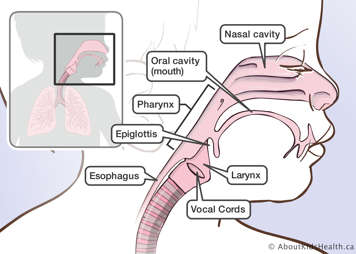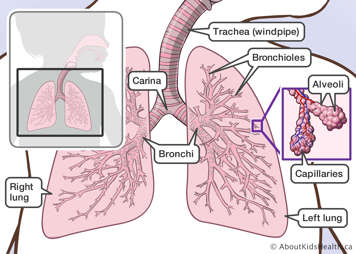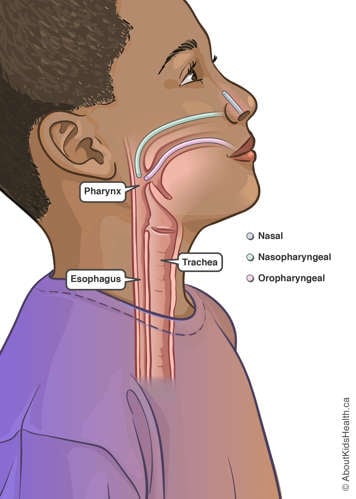What are secretions?
Secretions (mucus) are normally produced in the nose, mouth and trachea (windpipe). Secretions are usually clear or white.
A change in the colour, amount, consistency or smell of secretions may be the first sign that your child is getting sick or that something else is wrong.
The following are different types of secretions that your child may have and their common causes.
| Secretion characteristics | Potential causes |
|---|---|
| Thickened |
|
Yellow or green Foul smelling Increased production |
|
| Red-streaked or bloody |
|
| Frothy pink |
|
| Brown |
|
Important: If you notice a change in the colour, amount, smell or consistency of your child's secretions, contact your health-care team immediately.
What is suctioning?
Suctioning involves removing excess secretions from the nasal cavity (in the nose), mouth, throat and trachea. It is usually done with a device called a suction machine.
Why do I need to suction my child's airway?
You need to suction your child's airway because your child needs help to clear secretions that they cannot clear on their own through coughing or blowing their nose. This will help your child breathe more easily.
When do I need to suction my child?
Most children who need suctioning need to be suctioned at least three or four times a day. In particular, your child needs to be suctioned when:
- their cough is more frequent or sounds more congested than usual
- they are having trouble breathing or their breath sounds are harsh
- you can hear a gurgling noise while your child is breathing
- you suspect aspiration (your child has inhaled food and/or liquid)
What are the different types of suctioning?
There are four ways to suction your child's airway:
- Nasal suction (suctioning in the nose)
- Oral suction (suctioning the mouth)
- Nasopharyngeal and oropharyngeal suction (suctioning the throat)
- Deep suctioning


Nasal suctioning
With nasal suctioning, a catheter or small tip catheter is passed into the nostril. This is helpful when secretions are visible in the nose or you suspect that secretions are blocking the nasal passage.
Oral suctioning
For oral suctioning, a hard-plastic tip with a handle called a Yankauer is usually used to suction secretions in the mouth. Oral suctioning is useful when your child is unable to remove secretions by coughing (for example, they have a weak cough) or they are drooling because they cannot swallow.

Nasopharyngeal and oropharyngeal suctioning
A suction catheter (a thin, clear, soft plastic tube preferably with depth markings on it) is inserted to a predetermined depth through the nose (nasopharyngeal) or mouth (oropharyngeal) to the back of the throat. This type of suctioning is useful when secretions are pooled at the back of the throat and your child does not have the ability to cough them up or swallow them.
Deep suctioning
Deep suctioning lets you remove mucus from your child’s airway. This method is usually done with an artificial airway such as a tracheostomy tube. It removes mucus between the end of the tube and the carina (the part where the trachea splits into the bronchi, the tubes that go into the lungs). Deep suctioning is often done in urgent situations when secretions are unable to be removed by the other methods and the child is in distress.